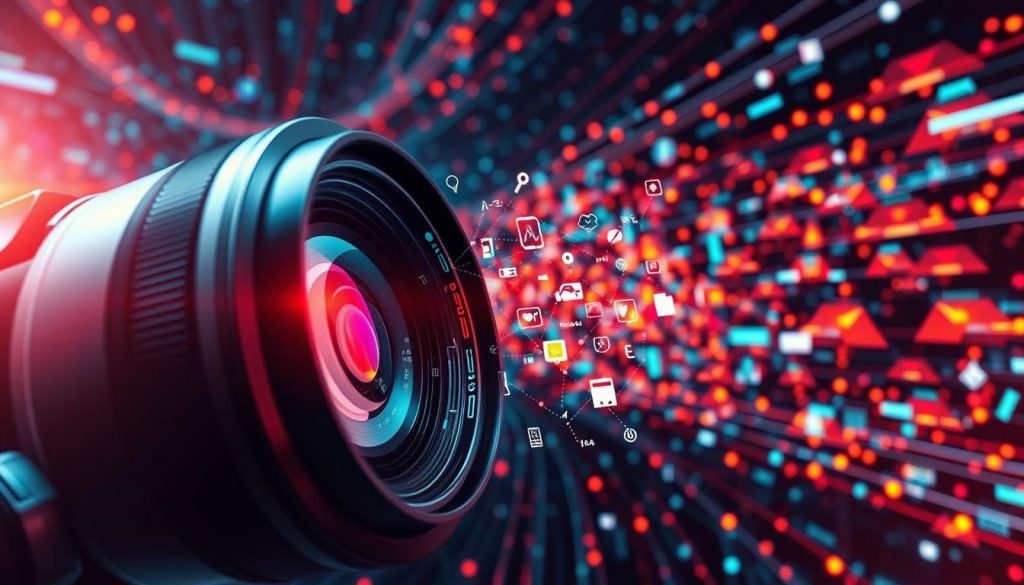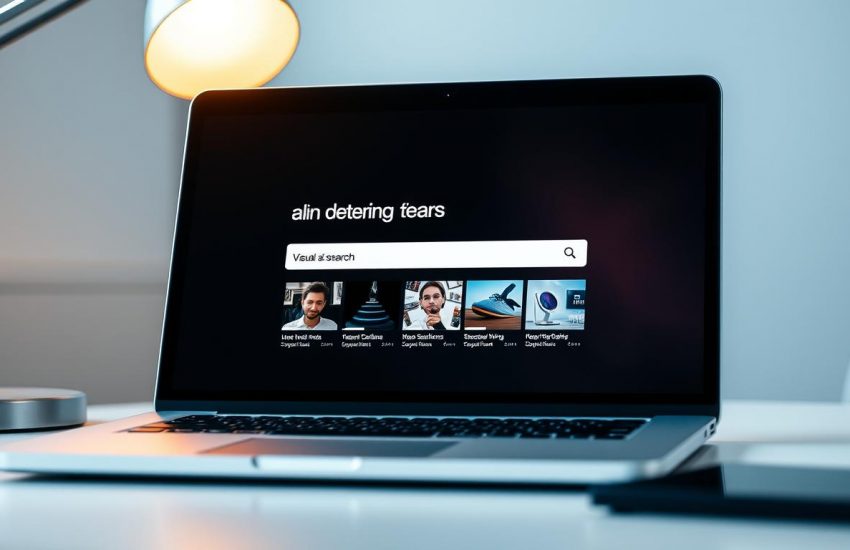Did you know that by 2025, visual search will drive over $31 billion in e-commerce sales in the United States alone? As a business owner, you know how key search engine optimization (SEO) is for your website’s text. But, optimizing your images and videos for search is just as important.
We’ll show you how to make your visual content more search-friendly. This will boost your search rankings and drive more traffic to your site. By using visual search optimization techniques, you can outdo your rivals and see real business growth.
Key Takeaways
- Understand the importance of visual search optimization for your business
- Learn how to optimize your images and videos for better search rankings
- Discover strategies to drive more traffic to your website using visual content
- Stay ahead of the competition with the latest visual search trends
- Improve your overall digital marketing strategy with visual search SEO
The Growing Power of Visual Search
Visual search is changing how we use the internet. As we move towards a more visual online world, making content for visual search is key. Businesses need to keep up with this trend to stay ahead online.
Why Visual Search Matters in 2023
In 2023, visual search is a big part of digital marketing. Google Lens and other tools let people search with images, not just text. This makes finding products and info easier.
More people are using visual search tools to find what they need. A report says the visual search market will grow as tech gets better.
How Google Lens and Other Visual Search Tools Work
Google Lens and similar tools use AI and machine learning to find objects in images. They give search results based on what they see. 
For example, Google Lens lets you take a photo of something and get info about it. This tech is changing how we explore and discover new things.
Visual Search Optimization Fundamentals
To make the most of visual search, businesses need to understand its basics. This includes both the technical and creative sides of making visual content easy to find.
The Technical Foundation of Visual Search
Visual search uses advanced algorithms to analyze images and videos. Image recognition technology is key, helping search engines spot objects and scenes. To optimize, your images must be technically sound, with the right formatting and metadata.
Also, the technical side involves structured data markup. Your website’s structure must let search engines easily find and index your visual content.

Differences Between Text and Visual Search Algorithms
Text and visual search algorithms work differently. Text search looks for keyword matches and context. But visual search focuses on the content and features of images and videos. Visual search is about understanding the visual elements and their connection to the search query.
This means optimizing for visual search needs a unique approach. You should focus on the quality, relevance, and context of your visual content.
Step-by-Step Image SEO Techniques
With visual search on the rise, optimizing your images is key. Good image SEO can really boost your website’s online presence. It also helps drive more traffic to your site.
Optimizing Image File Names and Formats
The first step in image SEO is to optimize your image file names and formats. Use descriptive names with target keywords. Also, choose the right file format for your images.
Best Practices for Image Naming Conventions
When naming your images, use descriptive names with relevant keywords. For example, “visual-search-seo-techniques.jpg” is better than “IMG_1234.jpg.” This helps search engines understand your image’s content.
Choosing the Right Image Format for SEO
Choosing the right image format is important. JPEG is great for photos, PNG for graphics and text images. WebP is a newer format that offers better compression.
Creating SEO-Friendly Alt Text
Alt text is key for image SEO. It gives search engines a description of the image. Write descriptive alt text with relevant keywords. For example, “A person using Google Lens to search for information on their smartphone.”
Image Compression Without Quality Loss
Compressing your images can make your website load faster. This is important for SEO. Tools like TinyPNG and ImageOptim can compress images without losing quality. “Image compression is a key step in image SEO,” says a leading digital marketing expert. “It directly impacts page load times and user experience.”
Advanced Image Search Optimization
To boost your image SEO, you need to use advanced techniques. These methods help improve your search rankings and bring more visitors to your site.
Contextual Placement of Images
Where you place your images matters a lot for search engines. Images near relevant text help Google understand them better. This makes your images more visible in search results. Make sure your images are placed strategically in your content for better SEO.
Using Descriptive Captions and Surrounding Text
Descriptive captions and text around your images are key for optimization. Captions add context for search engines, making your images more relevant. Surrounding text also helps search engines grasp the image’s topic, boosting its visibility.
Building and Submitting Image Sitemaps
Creating and submitting image sitemaps is vital for search engine discovery. An image sitemap helps search engines find your image content. By submitting your sitemap to Google, you can enhance your image SEO and grow your online presence.
Video SEO Best Practices
Video SEO is now key in digital marketing. It helps your videos rank better and engage more viewers. Focus on several areas to boost your search rankings and keep viewers interested.
Optimizing Video Titles, Tags, and Descriptions
Start by optimizing your video metadata. Use the right keywords in your titles, tags, and descriptions. Your title should be short, clear, and include your main keyword. Tags help search engines get your video’s context. Descriptions give a summary and can include more keywords.
Creating Clickable Video Thumbnails
A clickable video thumbnail boosts your video’s click rate. Use high-quality images that grab attention and match your video’s theme. Your thumbnail should make viewers want to click.
Implementing Video Transcripts and Closed Captions
Adding video transcripts and closed captions helps your video’s SEO. Transcripts give search engines text to index. Closed captions make your video easier to follow.
Transcript Optimization Techniques
Optimize your video transcripts with relevant keywords. This helps search engines understand your video’s content.
Multi-language Caption Strategies
For a global audience, use multi-language captions. It helps you reach more viewers and improve engagement worldwide.
By following these Video SEO tips, you can make your videos more visible. This will drive more traffic to your site and keep viewers engaged.
Schema Markup for Visual Content
Schema markup is key for making your visual content more visible in search results. It gives search engines extra details about your images and videos. This can boost your SEO by making your content stand out.
Implementing Image Schema Markup
Image schema markup helps search engines get what your images are about. To do it right, you need to pick the right schema types and properties.
ImageObject Schema Implementation Guide
With the ImageObject schema, you can share lots of info about your images. You can include things like contentUrl, description, and caption. Here’s an example:
{
"@context": "https://schema.org/",
"@type": "ImageObject",
"contentUrl": "https://example.com/image.jpg",
"description": "A detailed description of the image",
"caption": "Image caption"
}
Common Schema Markup Errors to Avoid
When using schema markup, steer clear of common mistakes. These include picking the wrong schema types, forgetting required properties, and messing up the JSON-LD format. Making sure your schema markup is correct and complete is essential.
Video Schema Markup Best Practices
Schema markup can also help your videos get found more easily. Use the VideoObject schema and include details like description, thumbnailUrl, and uploadDate. This can improve your video’s search ranking.
UX for Visual Content: Improving User Experience
In today’s visual search world, a good UX strategy can really boost your visual content’s impact. When you optimize images and videos for search, it’s key to make them engaging and easy for your audience to access.
Strategic Content Placement for Visual Assets
Placing visual assets wisely in your content can boost user interest. For example, using images and videos to break up text makes your content easier to read and share. Also, make sure your visual content fits well with the text around it, adding to the message’s strength.
Mobile-First Design for Visual Search
Most visual searches happen on mobiles, so a mobile-first design approach is essential. This means making your visual content load fast and look good on smaller screens. Think about mobile-specific features like touch-friendly designs and easy navigation to better the user experience.
By focusing on smart content placement and mobile-first design, you can greatly enhance your visual content’s UX. This makes it more findable and engaging for your audience.
Measuring Your Visual Search Performance
To see how well your visual search optimization is doing, you need to look at certain key metrics. These metrics help you understand how to make your SEO better.
Key Metrics for Visual SEO Success
Here are the main metrics to check for visual search success:
- Image and Video Engagement: Keep an eye on likes, shares, and comments on your visual content.
- Click-Through Rates (CTR): Watch how often people click on your images and videos in search results.
- Conversion Rates: Track how many conversions come from your visual content.
Analytics Tools for Tracking Visual Content
Choosing the right analytics tools is key for tracking your visual content’s performance. Some top tools are:
- Google Analytics: Gives you insights into how users interact with your visual content on your site.
- Google Search Console: Shows you how your images show up in search results and their CTR.
Platform-Specific Visual Search Strategy
To get the most out of visual search, knowing how each platform works is essential. Each platform has its own special features and how users behave. This means you need to adjust your visual search strategy for each one.
Let’s explore how to optimize for Google Lens, Pinterest, and Instagram. These are big names in visual search.
Google Lens Search Optimization Techniques
Google Lens lets users search with images. To make the most of Google Lens, make sure your images are top-notch and match what you’re showing. Use names and alt text that include the keywords you want to find. Also, put your images in the right place in your content to help people find them.
Pinterest Visual Search Marketing
Pinterest lets users find and save ideas with visual search. To use Pinterest’s visual search well, include the right keywords in your pin descriptions and hashtags. Make sure your images are eye-catching and work well on mobiles, as most people use Pinterest on their phones.
Instagram and Social Visual Search
Instagram is all about visuals, where people interact with content by liking, commenting, and sharing. To get the most out of Instagram’s visual search, use high-quality, engaging images. Use the right hashtags and Instagram’s shopping feature to boost sales and interest. Also, be regular with your posts and talk to your followers to get noticed more.
By making your visual search strategy fit each platform’s unique features and user habits, you can reach more people and get more engagement.
Future-Proofing Your Visual Search Marketing
Visual search marketing is on the verge of a big change. This is thanks to new tech like AI and augmented reality. We need to get ready with our strategies to keep up in the digital world.
AI and Machine Learning in Visual Search
AI and machine learning are changing how we use digital content. They make search results more accurate and personal. For example, AI can understand complex images and give the right results.
| Technology | Impact on Visual Search | Benefit |
|---|---|---|
| AI | Improved image recognition | More accurate search results |
| Machine Learning | Personalized search outcomes | Enhanced user experience |
Preparing for Augmented Reality Search
Augmented reality (AR) search is a new area in visual search marketing. It adds digital info to the real world, making experiences more immersive. Businesses should think about how to make their visual content work well with AR.
By using these new technologies, you can make your visual search marketing future-proof. This way, you can stay ahead of the competition.
Conclusion: Implementing Your Visual Search Optimization Plan
We’ve covered the basics and advanced methods of visual search optimization. Now, it’s time to start using what you’ve learned. By using the strategies from this article, you can boost your visual search ranking and get more visitors to your site.
First, work on making your images and videos better with the right keywords, alt text, and schema markup. Make sure your visual content works well on mobile devices and fits well in your website. Keep an eye on how well your efforts are doing with analytics tools.
By taking these steps and keeping up with visual search updates, you can improve your online presence. A good visual search optimization plan is key to reaching your digital marketing goals as visual search becomes more important.


